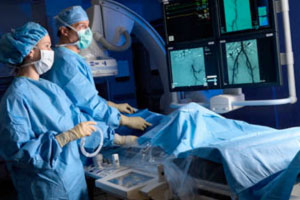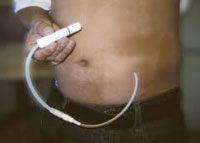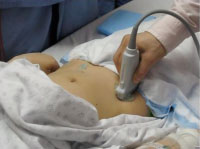PD Catheter Placement in the X-Ray Department
In the US, peritoneal dialysis (PD) catheters are most often placed by a general surgeon in an operating room (OR). The surgeon may do a small surgery to put the catheter into the abdomen. Or, the surgeon may use laparoscopic instruments with small cameras to show the best place to put the catheter into the belly. When an OR is used, you must see the surgeon and the anesthesiologist before you get a PD catheter placed. This means you have extra doctor visits.
Some medical centers offer other ways to place PD catheters besides in an OR. Ask if your PD catheter can be placed by an "interventional radiologist" in the X-ray department.
Radiology placement of PD catheters
 Interventional radiologists are specially trained X-ray doctors. They do medical procedures, using X-rays at the same time to help see what is going on inside the body. The types of X-rays used include ultrasound, fluoroscope, or CT scans. Many procedures can be done in an X-ray suite with just numbing medicine—not in an OR with an anesthesiologist. Many types of catheters can be placed in an X-ray suite, including PD catheters.
Interventional radiologists are specially trained X-ray doctors. They do medical procedures, using X-rays at the same time to help see what is going on inside the body. The types of X-rays used include ultrasound, fluoroscope, or CT scans. Many procedures can be done in an X-ray suite with just numbing medicine—not in an OR with an anesthesiologist. Many types of catheters can be placed in an X-ray suite, including PD catheters.
Experience with putting in PD catheters in the x-ray department has been published in medical journals. One study from the United Kingdom described 209 patients who had PD catheters placed this way. Doctors from the University of Alabama, Kaiser Permanente, and others have found success with this technique. Not all hospitals or X-ray departments offer this, so you will need to ask your doctor.
If a center does not have an interventional radiologist, they may still have kidney doctors who place PD catheters in much the same way—these are "interventional nephrologists".
Why it may be a plus to have an interventionalist place a PD catheter
If you can have a catheter placed in an X-ray suite, you need just one visit. You can use numbing medicine for your skin—not general anesthesia. And, these procedures are often easier to schedule than an OR. If you have medical problems that make surgery risky, a simple procedure in an X-ray suite may be a good fit for you. But, if you need other surgery at the same time that your catheter is placed (like a hernia repair), an OR may make more sense.
Where should the catheter go?
 If you and your care team choose PD catheter placement in an X-ray suite, talk with your doctor about where on your belly (or chest) the catheter will go. You will want the site to be planned ahead of time. It will need to be in a spot that is:
If you and your care team choose PD catheter placement in an X-ray suite, talk with your doctor about where on your belly (or chest) the catheter will go. You will want the site to be planned ahead of time. It will need to be in a spot that is:
- Comfortable
- Avoids irritation by a belt or other clothing
- Avoids skin folds that would be hard to keep clean
- Is easy to see and reach so you can care for it
The PD nurse can help you choose a spot, and can mark your skin so the doctor knows where the catheter would best be placed.
What to expect when your catheter is placed
 A day or so before your visit, many centers will ask you to take a laxative so your bowels will be clean. Just before your visit, you will be asked to empty your bladder. If you don't make a lot of urine, a catheter may be used to be sure your bladder is empty.
A day or so before your visit, many centers will ask you to take a laxative so your bowels will be clean. Just before your visit, you will be asked to empty your bladder. If you don't make a lot of urine, a catheter may be used to be sure your bladder is empty.
You will change into a gown, and lie down on an X-ray table. The skin of your abdomen will be cleaned. Lidocaine, a numbing medicine, will be used to make your skin numb. If you need it, the interventional radiologist can give you a mild sleeping medicine in your vein to help you relax.
The doctor can use a device that creates sound waves to make a picture (ultrasound) to find the right spot on your belly. He or she will make a small cut in your belly and start placing the catheter through your skin with the ultrasound pictures guiding the way.
 Once the peritoneum is entered, the doctor will change to a type of X-ray called "fluoroscopy" that gives larger pictures and can show real-time motion. This helps the doctor move the catheter to the right site inside your belly.
Once the peritoneum is entered, the doctor will change to a type of X-ray called "fluoroscopy" that gives larger pictures and can show real-time motion. This helps the doctor move the catheter to the right site inside your belly.
Once the doctor is sure the catheter is in the right spot, the small skin cut is stitched closed. You might need 4-5 stitches. A clean bandage is put over the stitches, left in place, and kept dry for at least a week. The PD nurse will teach you how to take care of your new PD catheter.
References:
- Abdel-Aal AK, Joshi AK, Saddekni S, Maya ID. Fluoroscopic and sonographic guidance to place peritoneal catheters: how we do it. Am J Roentgenol. 2009;192:1085-1089.
- Alvarez AC, Salman L. Peritoneal dialysis catheter insertion by interventional nephrologists. Adv Chronic Kidney Dis. 2009;16:378-385.
- Henderson S, Brown E, Levy J. Safety and efficacy of percutaneous insertion of peritoneal dialysis catheters under sedation and local anaesthetic. Nephrol Dial Transplant. 2009;24:3499-3504.
- Reddy C, Dybbro PE, Guest S. Fluoroscopically guided percutaneous peritoneal dialysis catheter placement: single center experience and review of the literature. Ren Fail. 2010;32:294-299.
- Vaux EC, Torrie PH, Barker LC, et al. Percutaneous fluoroscopically guided placement of peritoneal dialysis catheters: a 10-year experience. Semin Dial. 2008;21:459-465.
- Zaman F. Peritoneal dialysis catheter placement by nephrologist. Perit Dial Int. 2008:28:138-141.

